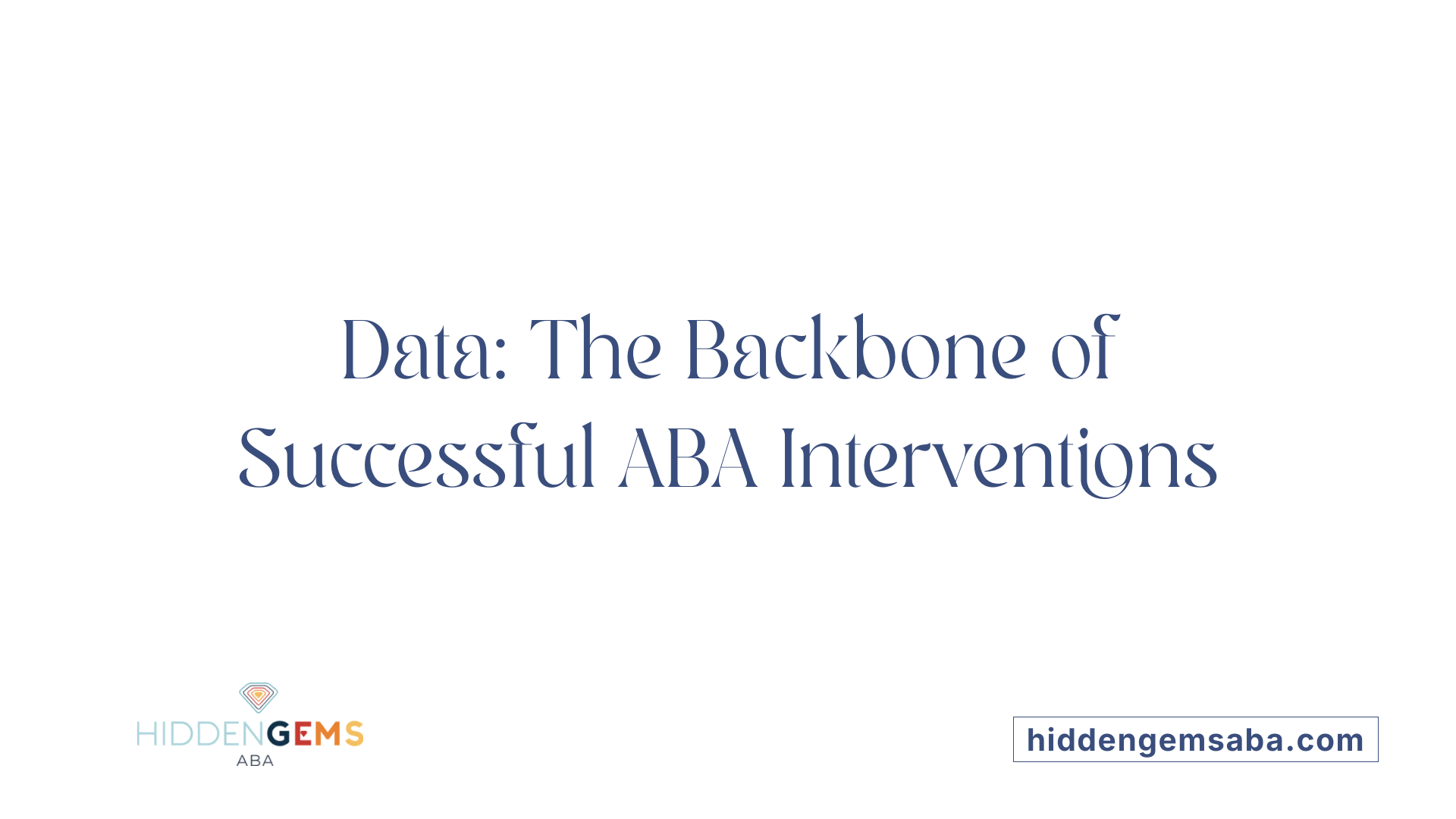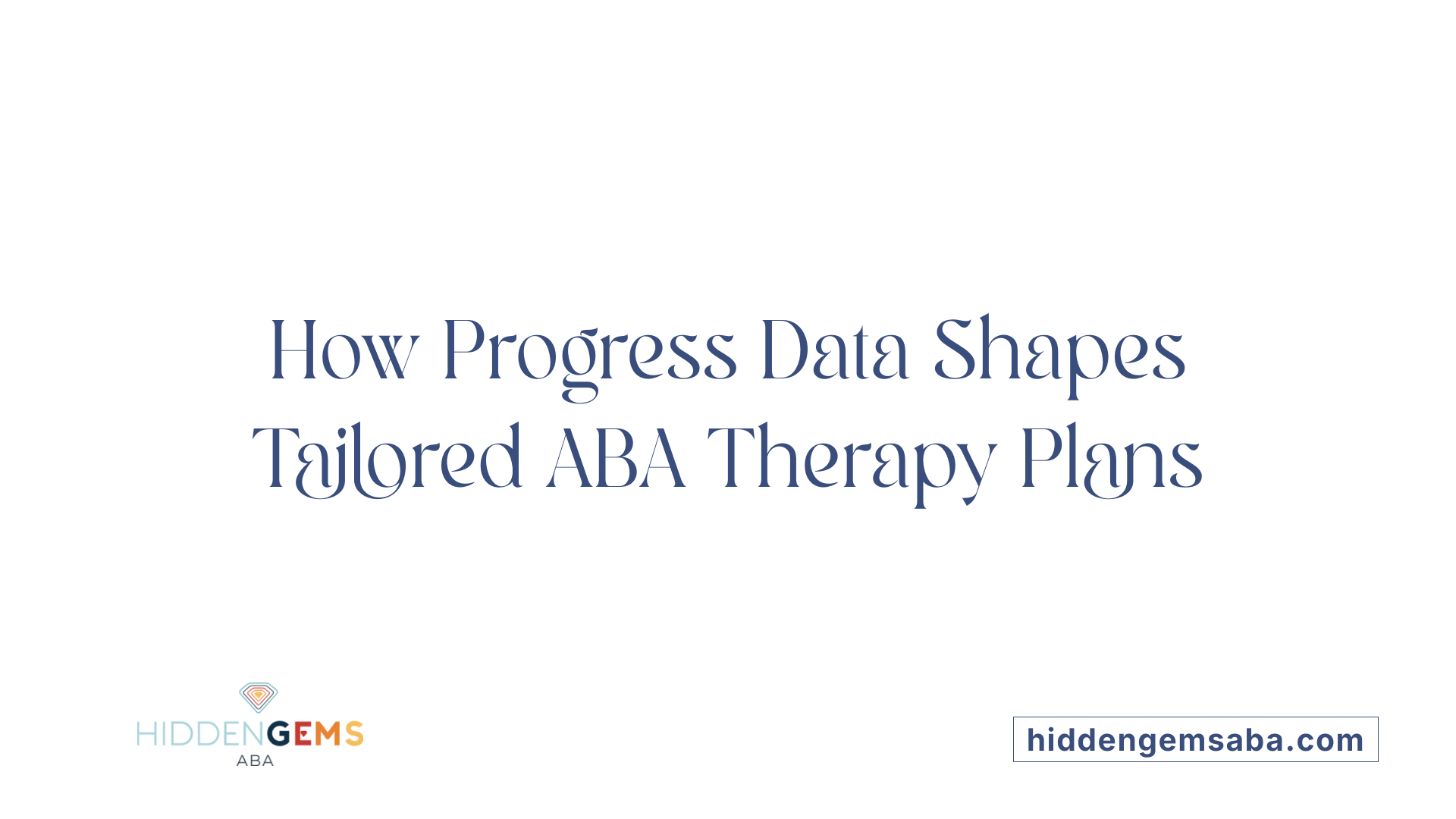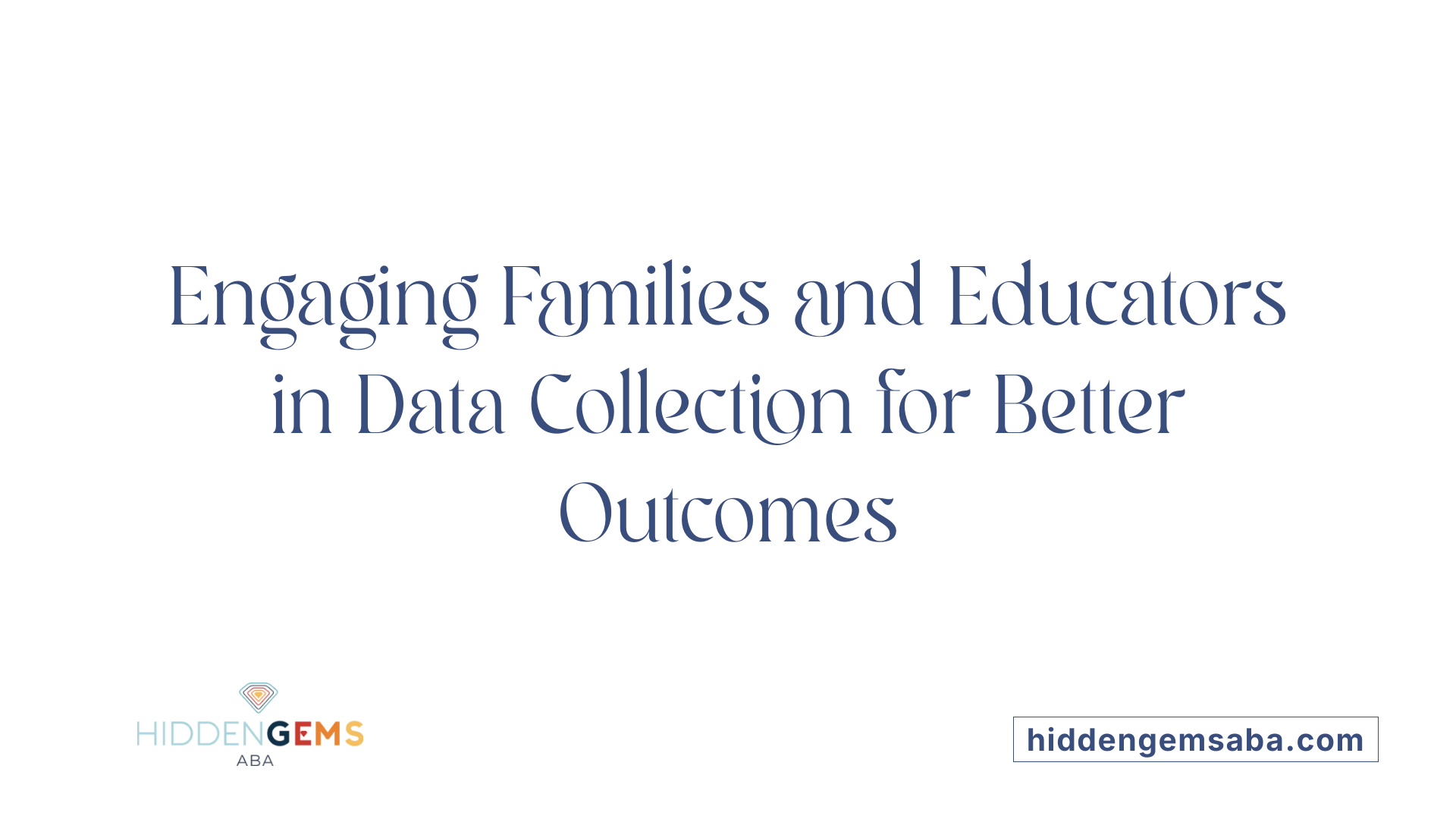Understanding the Foundation of Effective ABA Therapy
Tracking progress in ABA therapy hinges on systematic and accurate data collection. It is the backbone that supports evidence-based modifications, personalized interventions, and transparent collaboration among therapists, families, and educators. By understanding its critical importance, stakeholders can optimize therapy outcomes and ensure that every child's unique needs are addressed efficiently.
The Central Role of Data in ABA Therapy

Why is data collection so important in ABA?
Data gathering is at the heart of Applied Behavior Analysis (ABA) therapy. It provides objective, factual insights into a child’s behaviors and responses, which is crucial for tracking progress. Without reliable data, therapists would be guessing about whether their interventions are working or need adjustment.
Consistent and accurate data collection helps ensure that every decision is evidence-based. This means treatment plans are tailored precisely to meet the child's unique needs, with modifications made based on real data rather than assumptions.
Additionally, systematic data helps differentiate between genuine behavior changes and random variations. This scientific approach increases the effectiveness of interventions and ensures they are ethically sound.
Transparent communication with families and other stakeholders relies heavily on shared data. It fosters trust, keeps everyone informed, and encourages active participation in the child's therapy.
In essence, data collection is the backbone of ABA therapy, supporting targeted, measurable, and meaningful improvements in a child's development.
Best Practices for Monitoring Progress

What are the best practices for monitoring progress in ABA therapy?
Effective progress monitoring in Applied Behavior Analysis (ABA) therapy relies on consistent and objective data collection. Therapists utilize various methods such as frequency recording, duration measurement, latency assessments, and percentage of correct responses to gather reliable information about a child's behaviors and skills.
Regular analysis of the collected data helps identify patterns, establish baselines, and track changes over time. This continuous review allows therapists to determine whether interventions are successful or if adjustments are needed. Setting specific, measurable, achievable, relevant, and time-bound (SMART) goals guides the process and provides clear benchmarks for success.
Involving families in reviewing data ensures that progress is consistent across environments and contributes valuable insights from natural settings. Using advanced digital tools and ABA data management platforms can streamline data collection, improve accuracy, and facilitate real-time analysis.
Overall, a systematic approach—focusing on consistent data collection, regular review, and goal setting—supports personalized, effective therapy that adapts to a child's evolving needs.
Methods of Data Collection and Their Application

What methods are used for data collection in ABA?
Various techniques are employed in ABA to gather accurate, consistent data on a child's behaviors and progress. These include Permanent Product measurement, Duration Recording, Latency Recording, ABC Data collection, Frequency and Rate Recording, and Time Sampling recordings.
Permanent Product recording involves noting the tangible outcomes of behavior, such as completed tasks or acquired skills, which allows therapists to evaluate progress even when behaviors are not directly observable at all times.
Duration Recording measures how long a behavior lasts, offering insight into its intensity and frequency over a session. Latency Recording focuses on the time elapsed between a stimulus and the child's response, helping assess promptness and responsiveness.
ABC Data involves recording three components: Antecedent, Behavior, and Consequence, which assists in understanding the triggers and consequences of behaviors.
Frequency or Event & Rate Recording counts how often a behavior occurs within a set period. Time Sampling breaks observation periods into intervals to determine whether behaviors occur during specific segments, aiding in trend analysis.
Training all team members in these methods is essential for consistency and reliability across interventions. Clear, objective definitions for each targeted behavior ensure accurate data collection.
Incorporating digital tools or apps can streamline this process, making data more accessible for analysis and reducing human error. These advancements are vital for ensuring that data accurately reflects each child's progress and helps inform effective adjustments.
How do these methods support personalized intervention?
By consistently tracking behaviors through these diverse methods, therapists can identify what strategies work best for each child. Accurate data informs goal-setting, helps monitor skill acquisition, and highlights areas needing modification.
Ongoing data collection is particularly important during sessions, guiding immediate decision-making and ensuring that interventions remain aligned with the child's evolving needs.
Closing overview
Employing a variety of data collection techniques ensures a comprehensive understanding of a child's progress. When therapists, families, and caregivers use consistent methods, it enhances transparency, supports tailored strategies, and ultimately improves outcomes for children with autism.
The Significance of Ongoing Data Analysis and Pattern Recognition
How does data and progress monitoring help in evaluating goals and modifying intervention strategies in ABA?
Data collection and regular progress monitoring are cornerstones of effective ABA therapy. They offer a clear picture of how a child is developing over time by providing objective measures of behavior change.
By systematically recording behaviors through methods like ABC data, frequency, and duration measures, therapists can evaluate whether specific goals—such as improving social skills or reducing aggression—are being achieved. This ongoing evaluation helps determine if current strategies are effective or if adjustments are needed.
Regularly reviewing this data allows practitioners to identify behavioral patterns and triggers. For example, a spike in certain behaviors might indicate a specific environmental trigger or skill gap. Recognizing these patterns enables tailored modifications to interventions, ensuring they remain relevant and impactful.
Involving caregivers in data collection enhances the understanding of behaviors across settings and improves the accuracy of the assessment. Additionally, utilizing digital tools or apps streamlines data gathering, making it easier to analyze patterns and adapt strategies quickly.
Overall, continuous data analysis ensures therapy remains adaptive, personalized, and goal-oriented. It allows for timely, evidence-based decisions, ultimately supporting better outcomes for children with autism.
Personalized Treatment Planning through Progress Data

Why is progress tracking important for creating personalized and effective ABA treatment plans?
Monitoring a child's progress is fundamental for designing and adjusting ABA interventions that truly meet their unique needs. Progress tracking provides clear, objective data on how behaviors change over time, which is essential for tailoring therapy. Through methods such as frequency counts, duration, and ABC data recording, therapists can spot patterns and assess whether the current strategies are effective.
Regular data collection also allows for setting specific, measurable goals—often framed as SMART (Specific, Measurable, Achievable, Relevant, Time-bound) objectives. These goals help define what success looks like and enable parents and therapists to work together toward tangible milestones.
By analyzing progress data, behavior analysts can make informed decisions to modify interventions. This might involve intensifying effective strategies or shifting approaches when someone isn't responding as hoped. For example, if a child's social skills are improving with parent coaching but not in school, interventions can be adapted to address the inconsistency.
Engaging families in progress monitoring fosters transparency and consistency. Parents who understand how their child's behaviors are tracked can contribute valuable insights from natural settings, reinforcing interventions across environments.
Overall, ongoing progress data ensures that ABA therapy remains flexible, targeted, and effective, resulting in a personalized plan that adapts as the child's skills and challenges evolve.
Family and Educator Participation in Monitoring

How can parents, caregivers, and educators participate in data collection and progress monitoring in ABA therapy?
Active involvement from parents, caregivers, and teachers plays a crucial role in effective progress monitoring for children with autism. They can help by systematically recording behaviors using simple, consistent methods such as tracking how often specific behaviors occur (frequency data), how long they last (duration data), or noting specific incidents (anecdotal data). This information provides valuable insights into the child’s development and helps identify whether current strategies are effective.
In addition to data collection, families and educators can support ongoing progress by implementing therapeutic strategies consistently across home, school, and community settings. This consistency ensures that skills learned in therapy are reinforced in natural environments, facilitating skill generalization and behavioral support.
Collaboration is essential. Parents and teachers should work closely with ABA professionals through shared goal-setting and regular updates. Attending training sessions and observing therapy sessions can deepen their understanding of interventions, while providing feedback helps fine-tune approaches. Using tools like goal tracking sheets or visual graphs makes progress easier to see and understand, fostering ongoing motivation.
Naturalistic and home-based interventions are particularly effective when families and teachers actively participate. These approaches encourage practice of social communication and adaptive skills in everyday situations, making interventions more meaningful.
Moreover, advancements in telehealth services provide families with remote access to therapy, allowing them to participate more actively in data collection and progress assessment from home. This flexibility improves engagement and helps maintain a comprehensive picture of the child’s progress across different settings.
In essence, empowered families and educators who engage regularly in data collection and support consistent intervention are vital to achieving meaningful progress in children with autism.
The Future of Data Collection in ABA Therapy
What future advancements are expected in data collection for ABA?
The field of ABA therapy is rapidly evolving, with future developments focusing heavily on technological innovations. One major trend is the integration of artificial intelligence (AI) and more sophisticated digital tools. These advancements aim to make data collection more precise, efficient, and real-time.
AI-powered systems could automate the recording and analysis of behaviors, reducing human error and streamlining the entire process. For example, smart sensors and video analysis might automatically detect and log specific behaviors as they occur during sessions.
Collaboration platforms are also expected to improve, enabling seamless sharing of data among therapists, families, and other stakeholders. This can create a more transparent and responsive treatment process.
Enhanced data security measures are crucial as well, especially with sensitive client information. Future tools will incorporate advanced encryption and secure storage solutions to protect privacy while allowing authorized access.
Overall, these advancements will help clinicians tailor interventions more effectively, providing insights that support personalized and adaptive treatment plans. As technology continues to improve, the future of data collection in ABA promises to elevate the quality and impact of therapy for children with autism.
| Innovation Area | Expected Benefits | Additional Details |
|---|---|---|
| AI Integration | Automated behavior tracking and analysis | Real-time, unbiased data collection to inform immediate decisions |
| Digital Tools | Easier data entry and management | Apps and sensors that simplify routine tasks |
| Secure Sharing Platforms | Enhanced collaboration | Enables all team members and families to stay updated securely |
| Advanced Security Measures | Protect client data | Encryption and privacy protocols to ensure confidentiality |
Keeping pace with these changes will help ABA practitioners deliver more accurate, effective, and personalized therapy, ultimately improving outcomes for children and their families.
Ensuring Effective Progress Monitoring for Optimal Outcomes
Consistent and precise data collection, combined with thorough analysis and family involvement, forms the cornerstone of effective ABA therapy. By continuously refining data collection techniques, utilizing emerging technologies, and fostering transparent communication, practitioners can optimize intervention strategies and ensure meaningful progress for each child. The commitment to diligent progress monitoring not only upholds the integrity of ABA practice but also promotes the child's developmental success and overall well-being.
References
- Why Progress Monitoring Matters in Autism - A Better Way ABA
- Why Is Data Collection Important in ABA Therapy? | Blossom
- How ABA Therapy Data Collection Helps Parents & Therapists
- ABA Therapist Data Collection Best Practices and Techniques
- Data Collection in ABA Therapy for Children with Autism
- Toward an Understanding of Data Collection Integrity - PMC
- The Importance of ABA Therapist Data Collection | All Star
- Why do we collect data in ABA? - Sallyz Center For Autism
- Data Collection in ABA Therapy for Children with Autism





